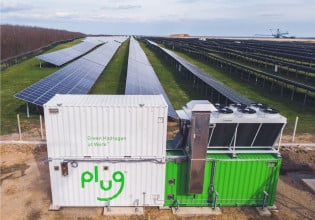Examining the Impact of Falling EV Battery Prices
Electric vehicle battery prices are predicted to fall by 40 percent, but what does it mean for the industry?
Dropping battery prices could allow electric vehicles (EVs) to reach cost parity with conventional internal combustion vehicles without requiring subsidies by 2025, according to a recent report by Goldman Sachs. Prices for EV batteries are predicted to fall by 40% over the next two years due to declining costs of raw materials, such as nickel, lithium, and cobalt.
Tesla’s 4680 battery cells. Image used courtesy of Tesla
Research into alternative battery chemistries may be one reason for falling prices. Years of metal price volatility have incentivized EV makers to consider battery materials that don’t rely on critical or rare minerals.
The average price of lithium-ion battery cells has fallen below $100 kWh for the first time in two years due to reduced raw material costs.
Electric Vehicle Supply and Demand
Rising EV adoption, primarily driven by government subsidies, is part of the equation when considering battery prices. However, global penetration is beginning to retreat from recent highs, hovering at around 12% of total passenger car sales as of June 2023 compared to 14% in late-2022. Governments in Europe and China have already rolled back EV subsidies.
EV battery setups for Ford’s Mustang Mach-E, F-150 Lightning, and E-Transit EVs. Image used courtesy of Ford
These are notable shifts from last year’s trends. Previously, rising EV sales spurred significant demand-related volatility for material inputs. Lithium, nickel, and cobalt prices increased in 2021 due to insufficient supply to meet demand. Nickel and cobalt prices have since stabilized with a surplus in supply.
Meanwhile, lithium started cooling when China’s EV demand slowed down this year. Other metals will likely continue a downward trajectory in the near term.
Raw Material Prices
Skyrocketing demand and component shortages have rocked the EV market in recent years, but the landscape is stabilizing thanks to new declines in metal prices.
Average battery pack prices from 2019 to 2030. Image used courtesy of Goldman Sachs
Lithium, nickel, and cobalt prices, commonly used in anodes, significantly drive the total decline. Battery makers use cheaper silicon-based anode materials, which replace or blend with graphite and offer higher energy density. After silicon-doped graphite entered the market, about 30% of anodes today contain silicon. Additionally, costs for module-free cell-to-pack designs, which boost volumetric density, stand at $26.56/kWh in 2023—down from $31 last year.
Cathode materials are also expected to fall in the coming year. The average cathode and anode prices are projected to decline by 41.9% and 17.6% in 2023, respectively. Lithium blends are also lower, with lithium-carbonate and lithium hydroxide dropping by more than 50%.
China, which dominates global battery material production, has also seen notable drops in metal prices. Nickel sulfate is down by 25% in 2023. Cobalt sulfate prices are the lowest in China, with lithium cobalt oxide averaging $100.1/kWh.
Lithium-ion battery material prices from 2015 to early 2023. Image used courtesy of the IEA
New Battery Technology
Low raw material prices could help ease cell manufacturing pressures, including high European electricity prices. New battery structures designed to increase cell sizes, like large cylindrical batteries, offer a simpler pack manufacturing process with less machine time and labor.
Average prices also reflect advancements in battery chemistry and performance, avoiding the need for expensive raw minerals. Lithium-ion battery alternatives have emerged recently, but technical gaps still limit their widespread adoption.
Sodium-ion batteries, for example, use readily available ingredients but only provide 75-160 Wh/kg of energy density compared to lithium-ion batteries’ 120 to 260 Wh/kg. Another alternative is zinc-based batteries, utilizing an abundant metal but with a lower power output.










